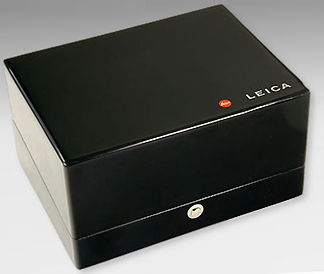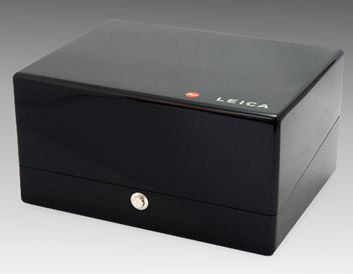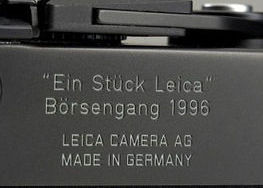|
LEICA M6 "Ein Stück Leica",
Börsengang. 1996
Leica AG, the path to IPO.
Leica Camera AG is a an investment holding Company with subsidiaries which produce
high quality photographic equipment for photography, scientific/technical reproduction,
as well as observation. Leica Camera forms as one of the core business which includes
design and manufacturing 35mm rangefinder / single reflex lens cameras as well as
optical lenses. More recently, the Company has also branched itself into manufacturing
of digital compact as well a high-end digital rangefinder/SLR cameras. Other less
significant businesses involvement include design and manufacturing of projectors,
enlargers, and binoculars etc. The Company's Headquarters is currently located in
Solms, Germany with production lines for various manufacturing activities in Germany
as well as in Portugal. Leica consumable and other technical products are distributed
by few primary subsidiaries and/or marketing arms in US, Japan, France, UK market
as well as assisted by a distribution network comprised of more than 100 localized
dealers and/or agents around the globe. Further, Leica has technical corporation
with a few major electronic conglomerate such as Panasonic Co. LTD, Japan for other
consumable products such as digital compacts, DV-cameras etc.
Leica had its root from Wetzlar, Germany. It was first started as Wetzlar Optisches
Institute back in 1849 by Carl Kellner who began producing small scales production
of optical corrected eyepiece, microscopes and other scientific purpose optical instruments.
He passed a way in 1955 and Friedrich Belthle took over the Optisches Institute after
married his widow. In 1864, Ernst Leitz joined in and inherited the business after
Belthle's death in 1869. Ernst Leitz changed the Company as E.Leitz , Wetzlar after
took control of the business on his own. It was during Ernst Leitz time that Leica
had improved considerably for their products in terms of quality as well as deploying
various manufacturing process to improve efficiency. During this period, Leica has
truly began to gain a recognizable trade name in the market for quality in optical
instruments. His son, Ernst Leitz II took over reign of the Company when Ernst Leitz
passed away in 1920. One of the most important milestone for Leica was, during this
stage Leica's first portable camera was developed.
 |
Probably the most well known figure in the development
of Leica cameras was Oskar Barnack. He was originally working for Zeiss Jena but
had decided to join Leitz under invitation of Ernst Leitz in 1911. The idea of a
compact camera was originated from the cine camera project that Oskar Barnack was
assigned with. He felt the 18x24mm cine film format was too small to deliver satisfactory
enlargement and had found a medium of 24x 36mm which would deliver sufficiently fine
grain result where the 2:3 proportion format was most ideal for a still camera. The
early prototype UR Leica camera body which eventually materialized has only a single
shutter speed and it was something like a raw and early compact camera design which
uses 35mm motion-picture film. The lens used for the UR Leica was an Elmar lens developed
by another optical microscope designer, Max Berek, he who had joined Leitz a year
after Oskar Barnack. One of the original picture by the early UR Leica camera was
at a scene at the countryside with Leitz family and it was still being kept today.
Credit: Image courtesy of J-camera Korea®. Image Copyright © 2008. All rights reserved. Please respect
the visual property of the contributing photographer.
SITE PREVIEW - 15/12/2008
|
In 1925, at Leipzig Spring Fair the photo community had witnessed an early compact
Leica cameras for the first time in public. The mobility it offers and the reasonably
high picture quality it capable of delivering had the photo community getting excited
and it was incredibly well received in particularly among the news and reportage
photographers users group. The agility and responsiveness in a compact camera was
instrumental in the development of photojournalism during this era and Leica camera
was soon embraced by professionals as well as serious photographers around the world
for its optical quality as well as responsiveness it offers. Many well-known photographers
of the time, including Henri Cartier-Bresson, Robert Capa etc. became faithful Leica
users and had indirectly spearheaded its popularity. Slowly, Leica with the threaded
mount has developed into a full camera system with further extended capabilities
like interchangeability of lenses and other system accessories. During the post war
period, Leica was more fortunate than another German label, Carl Zeiss who had most
of their production facilities ruined by constant bombardment by Allied forces and
hence Leica was recovered faster than Zeiss. To measure its popularity, by 1951,
Leica serial production for its camera has hit one millionth mark. In 1954, at the
Cologne Photokina, Leica introduced the first M-bayonet mount camera with the LEICA
M3 to replace the threaded mount system. Learning from the episode of the war, Leica
had decided to minimize risk of another devastating possibility of ruin and had opened
another production facilities across the continent in Midland, Canada. Some of the
production and camera/lenses assembling were moved to the American continent. Leitz
II died in 1956 and Leica was then managed by three of his sons; Ernst Leitz III,
Ludwig Leitz, and Günther. In 1966 a new production plant for Leica cameras
started operations in Oberlahn, near Weilburg, Germany (It was followed by another
new production plan later in 1973 which located at Vila Nova de Famalicao in Portugal).
A few years later, the competitions was again getting intense with a new rivalry
from the orient with their single lens reflex body, Nikon F debut in 1959. To counter
the aggression of the Japanese camera manufacturers, Leica introduced their first
single-lens reflex camera, the Leicaflex in 1965. It was followed by SL(1968), SL2(1974)
and eventually, Leica R3 in 1976. Mid between all these developments, Leica had once
partnered Minolta to produce a series a compact CL series bodies. Similarly, domestic
long time rivalry, Carl Zeiss had sold to Kyocera which had their first professional
class SLR model, Contax RTS in
1974. Both domestic and international competitions in the market place actually had
Leica went through some difficult periods. Besides, interim event such as failed
introduction of LEICA M5. After 1972, with Japanese unveiled series of highly successful
consumable SLR camera models such as Nikon F2 Systems
as well killer electronic SLR camera model such as Canon AE-1, the
market trend was inclined to more complete SLR system than rangefinder. For an example,
the Canon AE-1 with only Shutter Priority AE automation was incredibly well received
and it was said to have been sold more than a million units with a single production
model. This had Leica reverted its strategy by consolidating its core resources back
to rangefinder system with Leica SLR system slowly trying to find an opening amidst
all the Japanese clear dominance in the SLR market. It was during this time that
the Leica M4-2 was introduced in 1977 with a more successful M4-P debut a few years
later.
 |
 |

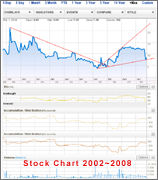 |
|
Primary Subsidiaries:-
Leica Camera Inc. (United States)
Leica Camera S.A.R.L. (France)
Leica Camera Ltd. (United Kingdom)
Leica Aparelhos Opticos de PrecisaoS.A.(Portugal)
Leica Camera Japan Co., Ltd.;
Leica Cinema GmbH, Zurich, Switzerland
Others w/unclear status:-
Minox GmbH Optische und Feinmechanische Werke (Germany); ACM Projektentwicklung GmbH.
Leica Cinema GmbH, Zurich, Switzerland. |
|
USEFUL LINKS:-
LEICA
Corporate Info - Basic search on
background of the Company
Investors relation:
Comprehensive information relating to the finances of Leica Camera AG - company reports,
financial announcements and the statement of Corporate Governance principles - provides
you with a detailed insight into the Company.
Annual Report Downloads: Available periods from 2002~2008
Press
Rooms: Latest press reports or
articles from the press archive
Live Stock Quote:-
Leica Camera AG (Stock Quote: LCAGk)
LCAGK listings on other Stock Exchanges:-
LCAGk.H - Hamburg Stock Exchange
LCAGkEUR.Lp - London Stock Exchange
LCAGk.DE - XETRA Level 1
LCAGk.F - Frankfurt Stock Exchange
LCAGk.BE - Berlin Stock Exchange
LEIMF.PK - Pink OTC Market Exchange
LCAGk.MU - Munich Stock Exchange
LCAGk.D - Dusseldorf Stock Exchange
Historical Stock Chart / Stock Performance since its listing
Number of shares listed: 15.0 million (March 31, 2007: 15.0 million)
Shareholders (as of March 13, 2008):
– ACM Projektentwicklung GmbH: 96.51%
– Free float: 3.49%
Financial Highlights (2007/2008);-
Turnover Euro ¤156,238,000; Profit (Nett):- ¤3,042,000
EURO
EPS (Earnings per share) : 0.19¤
|
| |
|
Inside Leica, there were changes and some internal corporate reshuffling was occurred
during the '80. Firstly, Leica seemingly had found a life line with the hugely successful
Leica M6 introduced in 1984. In 1986, last of the Leitz family retired as board of
directors and more importantly, LEICA GmbH was formed by merging series of smaller
Leitz Companies as a single entity. Further changes was, the camera/lens production
was relocated to current premises in SOLMS in years between 1986~88. In 1990, the
holding Company had merged with another British Company, Cambridge Instrument Co.
Ltd. with the camera/lenses division under Leica GMbH was renamed as Leica Camera
AG. Another major decision was made in 1991 with Canadian Midland operation being
disposed off in 1991. A management buyout was first brought up in 1992 but it was
not successful. It was re-attempted by Klaus-Dieter Hofmann in 1994 and the exercise
was completed in 1994 and Leica from here has changed itself as an independent Leica
Camera AG.
Management buyout costs Money. The takeout for the financiers who backed the exercise
was an eventual planned corporate exercise of a IPO (initial Public Offering) and
it was materialized in 1996. Approx. 4.5m shares was sold to public and subsequently
Leica had successful seek a listing on the Frankfurt stock exchange and had turned
itself from private entity all these years as a PLC (public Listed Company). Ref:
Leica Collector's Guide by Dennis Laney, answers.com; LA Times, Business Weekly |
| |
|
|
|
 |
LEICA M6 "Ein Stück Leica",
Börsengang. 1996
To commemorate the special occasion of IPO and
successful listing on the Frankfort Stock Exchange in 1996, Leica had released a
special edition Leica M6 to mark a milestone in Leica corporate development. After
here onwards, Leica departed itself from century long private entity into a public
Listed Company.
|
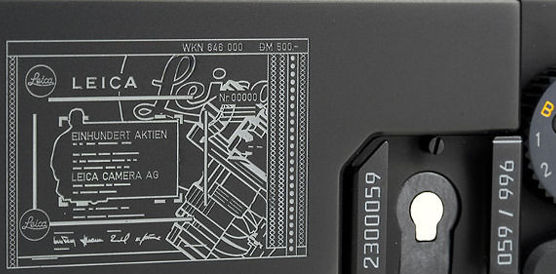 |
This special LEICA M6 model was rather unique in quite
a few ways. Firstly, most noticeable was the appearance, in particularly the body
covering. Instead of conventional leatherette used, Leica had redesigned a new body
covering with tiny repetitive small embossed LEICA logos. Basically, nice in its
appearance but probably this was the first M-model that started to offer with a non-natural
leatherette. Another more prominent feature was an engraving of a LEIVA share certificate
in denomination of DM500 with indicative S/N. 0000 at the top plate.
|
| Credit: Image(s)
courtesy of some nice folks from DigifanCN®.
The group also operates
their own active, popular EBAY STORE,
trading for many major
camera brands and collectibles. Image Copyright © 2008. All rights reserved.
Please respect the visual property of the contributing photographer. |
|
 |
 |
A complete package of LEICA M6 "Ein Stück Leica" Börsengang 1996 model
for collection should include the matching SUMMILUX-M
35mm f/1.4 ASPH wideangle lens in black finish.
Technically, the -M 1.1:4/35 ASPH supplied was Mark II series. It was reported it
has production S/N coding with 3758xxx (while the earliest series should have 346xxxx.
Anyway, it is not so important as individual lens has matched Edition S/N with the
camera Edition S/N i.e. xxx/996 engraved. The lens has excellent handling and various
lens features displaying properties, probably the only thing you can picked on is
the tiny ridged aperture control ring. The depth of field scales almost have all
the working apertures covered, except for f/2.0 & f/4.0. |
|
 |
 |
|
Another rather unconventional
feature was the lens data at the front section of the
"Ein Stuck Leica" Summilux-M 1:1.4/35 ASPH wideangle lens were dimmed or
rather painted in gray.
|
Leica M6 "Ein Stuck" 996 units of these were made in 1996. It depends on
how affectionate you are with the trade name LEICA. After all, it was a special edition
released to celebrate Leica entering the public stock exchange and it was done in
the most appropriate fashion with a special edition camera/lens combo as LEICA was
itself a camera/lens manufacturer. Probably to those who may have great passion towards
the long established tradename in the business, it carried more meaning than any
other previous releases and thus it has a specially engraved top plate showing a
share of Leica stock. Serial numberings for this edition range from 2300001 to 2300996
with the first unit, bearing serial number 2300000 was kept as a showcased unit at
Leica museum to mark the corporate development of the Company.
 |
Credit: Image(s)
courtesy of IL-Contatto®,
Italy who also operates a popular trading place. All Images Copyright © 2008. All
rights reserved. Please respect the visual property of the contributing photographer.
|
| |
|
Each unit of the LEICA M6 "Ein Stuck" 996 carries
with an authentication via an accompanying certificate bearing the signature of Mr.
Klaus-Dieter Hofmann, the then President of the Leica Camera AG, as well as Mr. Wolfgang
Muller, the Executive Vice President for Marketing and Sales for LEICA AG. Well,
although personally I see it as an unnecessary move, but Leica had also convinced
other celebrities such as an addition authenticity via separate card with an add-on
signature of Mr. Sebastiao Salgado, a famous Leica photographer.
 |
Credit: Image(s) courtesy of Mr. Peter Coeln from LEICA Shop®, Austria who also operates a popular Westlicht Auction House. Image Copyright © 2008. All rights
reserved. Please respect the visual property of the contributing photographer.

OTHER VIEWS of this LEICA M6
Basic Views | Related
Views
|
Anyway, more logically I would think its collectible status can be evaluate from
another perspective i.e. as a trader quoted it rightly "... a brand new normal
LEICA SUMMILUX-M 35mm F1.4 is selling at 4300US$, a brand new normal LEICA M6 is
worthy 3000US$. Now, it is your chance to own this special limited kit set of M6+35/1.4
ASPH at 6980US$ only! Even cheaper than a normal version !.." make more
sense than anything, isn't it ? |
|
Main Index Page
- Leica M6-series models / Main Index Page - Leica-M Rangefinder
camera Models
Nomenclature / Main Reference Map for Leica M6 Standard Model(s) applicable to this Leica M6 Classic Platinum
Anton Bruckner 1824~1896 Edition
Instruction Manuals:- Leica M6 Classic in PDF (3.8mb) applicable to this M6 Classic Platinum Edition by Niels
H. S. Nielsen
| Message Board | lenses | Message Board | RF cameras

about this site
|







